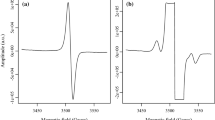Abstract
European standards EN1787 and EN13708 specify spectroscopic methods for the detection of irradiated food. Electron spin resonance (ESR) spectral characteristics of radiation-induced radicals in standard marker materials (cellulose, glucose, fructose, and saccharose) were compared. Standard marker materials were gamma-irradiated (0 and 10 kGy) and mixed at different blending ratios (0–100 %) to evaluate their sensitivity upon ESR detection. Blended samples produced specific ESR signals which showed increased intensities by an increasing percentage of the irradiated component. However, detection was possible with 30 % irradiated component. The results could be helpful in interpreting complex ESR signals in plant materials containing cellulose and sugar materials.




Similar content being viewed by others
References
Jo D, Sanyal B, Lee JW, Kwon JH (2015) Thermoluminescence characterization of isolated minerals to identify oranges exposed to γ-ray, e-beam, and X-ray for quarantine applications. J Radioanal Nucl Chem 303:297–304
Monique L, Samia A, Dominic D, Me´lanie T, Ste´phane S, Takala P, Khang VD (2013) Irradiation in combined treatments and food safety. J Radioanal Nucl Chem 296:1065–1069
Shahbaz HM, Ahn JJ, Akram K, Kwon JH (2013) Screening methods for the identification of irradiated foods. Curr Res Agric Life Sci 31:1–10
Akram K, Ahn JJ, Kwon JH (2012) Analytical methods for the identification of irradiated foods. In: Belotserkovsky E, Ostaltsov Z (eds) Ionizing radiation: applications, sources and biological effects. Nova Science Publishers, New York, pp 1–36
EN1786 (1997) Foodstuffs-detection of irradiated food containing bone: analysis by electron paramagnetic resonance. European Committee for Standardization (CEN), Brussels
EN13708 (2001) Foodstuffs-detection of irradiated food containing crystalline sugar by ESR spectroscopy. European Committee for Standardization (CEN), Brussels
EN1787 (2000) Foodstuffs-detection of irradiated food containing cellulose by ESR spectroscopy. European Committee for Standardization (CEN), Brussels
Raffi J, Yordanov ND, Chabane S, Douifi L, Gancheva V, Ivanova S (2000) Identification of irradiation treatment of aromatic herbs, spices and fruits by electron paramagnetic resonance and thermoluminescence. Spectrochim Acta A56:409–416
Marchioni E (2009) ESR for food irradiation detection. In: Guỡjònsdóttir M, Belton PS, Webb GA (eds) Magnetic resonance in food science. Royal Society of Chemistry, Cambridge, pp 195–204
Delincée H, Soika C (2002) Improvement of the ESR detection of irradiated food containing cellulose employing a simple extraction method. Radiat Phys Chem 63:437–441
Bayram G, Delincée H (2004) Identification of irradiated Turkish foodstuffs combining various physical detection methods. Food Control 15:81–91
Esteves MP, Andrade ME, Empis J (1999) Detection of prior irradiation of dried fruits by electron spin resonance (ESR). Radiat Phys Chem 55:737–742
Ghelawi MA, Moore JS, Dodd NJF (1996) Use of ESR for the detection of irradiated dates (Phoenix dactylifera L.). Appl Radiat Isot 47:1641–1645
Malec-Czechowska K, Strzelczak G, Dancewicz AM, Stachowicz W, Delincée H (2003) Detection of irradiation treatment in dried mushrooms by photostimulated luminescence, EPR spectroscopy and thermoluminescence measurements. Eur Food Res Technol 216:57–65
Sudprasert W, Monthonwattana S, Vitittheeranon A (2012) Identification of irradiated rice noodles by electron spin resonance spectroscopy. Radiat Meas 47:640–643
Shimoyama Y, Ukai M, Nakamura H (2006) ESR detection of wheat flour before and after irradiation. Spectrochim Acta A63:888–890
Lee JH, Ahn JJ, Akram K, Kim GR, Kwon JH (2012) Comparison of ESR spectra of irradiated standard materials using different ESR spectrometers. J Korean Soc Appl Bi 55:407–411
Acknowledgments
This research was supported by Basic Science Research Program through the National Research Foundation of Korea (NRF) Grant funded by the Ministry of Education (MOE) (No. NRF-2013R1A1A4A03006993).
Author information
Authors and Affiliations
Corresponding author
Rights and permissions
About this article
Cite this article
Shahbaz, H.M., Kyung, HK., Kim, HY. et al. Analysis of electron spin resonance spectra for the identification of complex ESR signals using irradiated standard marker materials. J Radioanal Nucl Chem 306, 93–97 (2015). https://doi.org/10.1007/s10967-015-4075-8
Received:
Published:
Issue Date:
DOI: https://doi.org/10.1007/s10967-015-4075-8




